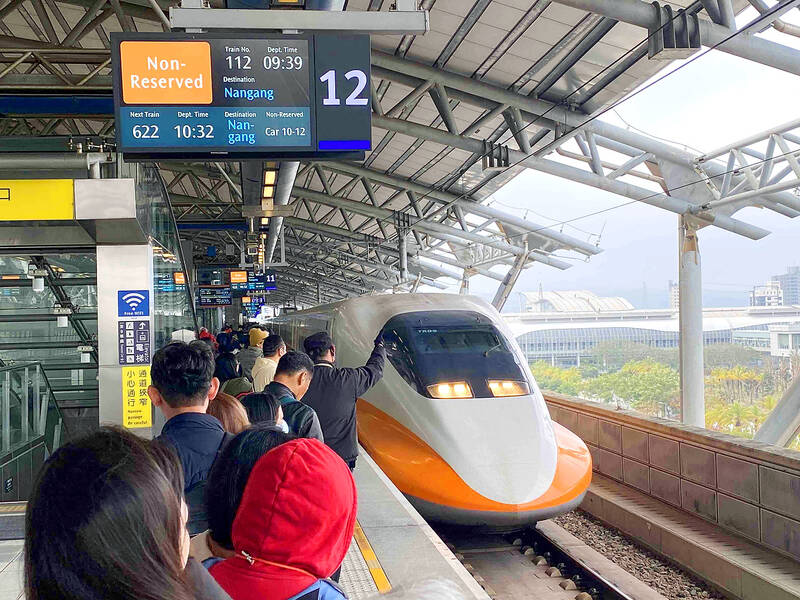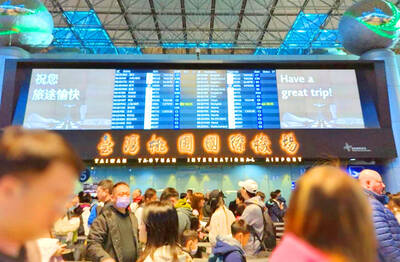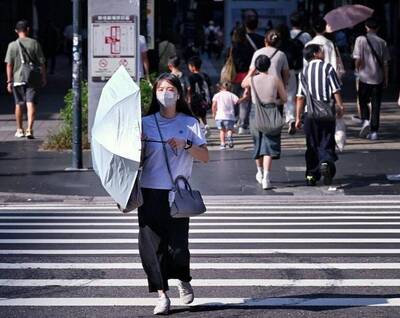Planned high-speed rail (HSR) extensions would blanket Taiwan proper in four 90-minute commute blocs to facilitate regional economic and livelihood integration, Railway Bureau Deputy Director-General Yang Cheng-chun (楊正君) said in an interview published yesterday.
A project to extend the high-speed rail from Zuoying Station in Kaohsiung to Pingtung County’s Lioukuaicuo Township (六塊厝) is the first part of the bureau’s greater plan to expand rail coverage, he told the Liberty Times (sister paper of the Taipei Times).
The bureau’s long-term plan is to build a loop to circle Taiwan proper that would consist of four sections running from Taipei to Hualien, Hualien to Taitung and Taitung to Kaohsiung in addition to the section from Kaohsiung to Taipei, with each segment taking 90 minutes to travel, he said.

Photo: Huang Hsu-lei, Taipei Times
The travel time is the standard for linking locations with high-speed rail, as it enables people to complete a round trip in three hours, allowing same-day commutes, he said.
Taiwan’s eastern seaboard relies on inherently slow conventional rail lines that make use of circuitous routes, which renders the system susceptible to outages from natural disasters and further decreases speed, Yang said.
Building high-speed railways around Taiwan would be a significant boost to economic development on the east coast, he said.
However, the Kaohsiung-Pingtung plan has sparked uneasiness among Kaohsiung residents, as the project could potentially disrupt traffic in the city’s busy downtown area, he said.
The bureau is conducting extensive studies to explore engineering solutions and is confident that the project can utilize tunnel shielding to avoid impeding traffic on the city’s busy Jhonghua and Minzu roads, he said.
Officials expect to break ground on the Kaohsiung-Pingtung project in the first half of 2028 and complete it within about 11 years, Yang said.
The project would be largely unaffected by the legislature’s budget cuts, as its funding draws entirely from the Forward-looking Infrastructure Development Program, although the loss of travel funds would inconvenience the bureau’s efforts to arrange in-person meetings with local officials, he said.
Separately, Deputy Minister of Transportation and Communications Chen Yen-po (陳彥伯) on Thursday said that the ministry aims to achieve a 20 percent reduction in carbon emissions by 2030 and a 33.4 percent reduction by 2035 against 2005 levels.
This would entail efforts to increase public transportation capacity, create a friendly environment for pedestrians and bicycles, and support electric vehicles and energy efficient vehicle technologies as well as sustainable aviation fuel, he told a meeting of the National Climate Change Committee in Taipei.
Highlights of the ministry’s programs include integrating rail, metro and YouBike to enable end-to-end public transportation, and the total substitution of privately owned gas-powered vehicles for electric ones by 2040, he said.
In addition, sustainable aviation fuels are being introduced to the airports in Taoyuan, Taipei and Kaohsiung, with the goal of replacing 5 percent of the fuel used by airplanes, he said.
In 2022, Taiwanese vehicles released 36.28 million tonnes of carbon, or 12.69 percent of the nation’s total emissions, he said, adding that the figure also marked an increase of 840,000 tonnes compared with the previous year.
Transportation is the nation’s fourth-largest contributor to greenhouse gases behind manufacturing, energy, and residential and commercial emissions, he said.
Passenger vehicles and light trucks accounted for 48.99 percent and 17.77 percent of all transportation-related emissions respectively, while 96.32 percent of all transport emissions originated from vehicles on roadways, he said.

Three Taiwanese airlines have prohibited passengers from packing Bluetooth earbuds and their charger cases in checked luggage. EVA Air and Uni Air said that Bluetooth earbuds and charger cases are categorized as portable electronic devices, which should be switched off if they are placed in checked luggage based on international aviation safety regulations. They must not be in standby or sleep mode. However, as charging would continue when earbuds are placed in the charger cases, which would contravene international aviation regulations, their cases must be carried as hand luggage, they said. Tigerair Taiwan said that earbud charger cases are equipped

Foreign travelers entering Taiwan on a short layover via Taiwan Taoyuan International Airport are receiving NT$600 gift vouchers from yesterday, the Tourism Administration said, adding that it hopes the incentive would boost tourism consumption at the airport. The program, which allows travelers holding non-Taiwan passports who enter the country during a layover of up to 24 hours to claim a voucher, aims to promote attractions at the airport, the agency said in a statement on Friday. To participate, travelers must sign up on the campaign Web site, the agency said. They can then present their passport and boarding pass for their connecting international

Temperatures in northern Taiwan are forecast to reach as high as 30°C today, as an ongoing northeasterly seasonal wind system weakens, the Central Weather Administration (CWA) said. CWA forecaster Tseng Chao-cheng (曾昭誠) said yesterday that with the seasonal wind system weakening, warmer easterly winds would boost the temperature today. Daytime temperatures in northern Taiwan and Yilan County are expected to range from 28°C to 30°C today, up about 3°C from yesterday, Tseng said. According to the CWA, temperature highs in central and southern Taiwan could stay stable. However, the weather is expected to turn cooler starting tonight as the northeasterly wind system strengthens again

Taiwan sweltered through its hottest October on record, the Central Weather Administration (CWA) said yesterday, the latest in a string of global temperature records. The main island endured its highest average temperature since 1950, CWA forecaster Liu Pei-teng said. Temperatures the world over have soared in recent years as human-induced climate change contributes to ever more erratic weather patterns. Taiwan’s average temperature was 27.381°C as of Thursday, Liu said. Liu said the average could slip 0.1°C by the end of yesterday, but it would still be higher than the previous record of 27.009°C in 2016. "The temperature only started lowering around Oct. 18 or 19